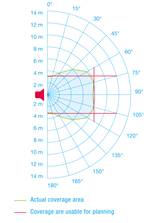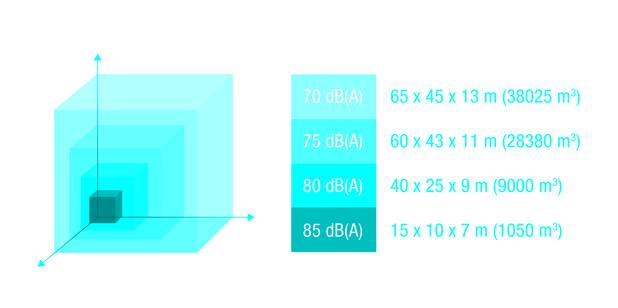3D-Coverage: performance in a given space is crucial
Coverage volume parameter improves planning security
Audible and visual signaling devices can significantly reduce residual risk in the workplace. However, they only provide effective protection for people and property if the correct devices are chosen for the application. Pfannenberg has devised a new, practical demonstration method which for the first time visualises the actual performance of signaling devices in a given space under real environmental conditions, thus helping planners to design the ideal signaling solutions.

In many safety-related areas, norms and regulations require that visual and/or audible signaling devices are used – in fire and gas alerting, for example, or workplace and machine safety. Up to now there have been no concrete specifications for the efficiency of signaling solutions. Manufacturers are often unable to give any meaningful data for the effectiveness of their products. As signaling devices initially look very similar and the relevant product data sheets generally offer too little in the way of orientation, the purchase price becomes in many cases the most important selection criterion – with high-risk consequences.
This situation results frequently in the installation of inappropriate signaling devices only to comply with the vaguely formulated minimum requirements. The resulting systems are often under-specified, presenting a safety risk, or over-specified, resulting in unnecessarily high costs. There is a risk that the sub-optimum performance of the signaling device will only be discovered when danger really threatens. Those responsible for operations are risking the health of their staff and costly damage to buildings, machines, systems and processes.
Location impacts performance
The greater the safety-related function of a signaling device in the application, the more important the actual coverage volume. Particularly in an alerting application, efficiency can be of crucial, even vital, importance. Workers today are faced with an increasing sensory overload as the result of the many operational signals present at their workplace. This makes it more difficult for them to perceive alarm signals and to interpret them correctly so the careful choice of a signaling solution is even more important.
Not every signaling device fulfils the requirements of an alerting device. In order to select the appropriate signaling device, it is essential that the environmental conditions at the 3 location where it is to be used are taken into account. Every space presents different requirements: factors such as the size and architectural features of the space, the way light falls, the signal tone used, the ambient noise level and the type and position of the workspaces in the area are crucial factors influencing the performance required of the signaling devices.

Pfannenberg is the first manufacturer to present "3D Coverage", a practical method for demonstrating the effective performance of audible and visual signaling devices in a given space. 3D coverage provides a value which goes beyond the traditional information supplied on a technical data sheet. For example, the coverage volume of audible signaling devices is always determined after consideration of the ambient noise in dB(A) and signal tone (e.g. DIN tone). It is specified through the height, width and length of the space to be covered by the signal. Using a cost-free online planning tool, Pfannenberg Sizing Software (PSS), it is possible to calculate individual values.
Hidden differences are revealed
Pfannenberg 3D Coverage reveals previously undetectable differences in performance. For example, each sounder achieves different sound levels depending on the angle of emission to the source of the sound. These levels are highest as a rule in front of the device (90°) and recede significantly at the sides (0°/ 180°). The design of many sounders means that they emit insufficient sound forwards and usually inadequate amounts to the side and downwards. Their radiation characteristic delivers a correspondingly small coverage volume. Signaling devices from Pfannenberg, on the other hand, have optimized sound emission which allows the sound to be carried over a wide area.

The technology used to produce the noise also has an impact on effectiveness.
Piezo technology is used in many cheaper sounders. Low power consumption only makes them attractive on paper, particularly for fire alerting. However, when their performance is taken into consideration, it becomes clear that their coverage volume is much lower than that of electro-dynamically produced sound, which is used in Pfannenberg signaling devices. Looking at the coverage volume and the power 5 consumption in relation to each other, it can be seen that electro-dynamically generated sound is much more efficient than that generated with piezo electricity.
Similarly, an evaluation of a visual signaling device depends on more than just one light intensity reading. For example, lens shape and the light source used are crucial to its effectiveness. The light color is also taken into account, as it affects the coverage capability.
Solving, not creating problems
Planning with Pfannenberg 3D Coverage makes it possible to visualise and compare the performance of signaling devices taking account of actual environmental conditions for every application and type of alert, whether for fire alerting, machine and instrument safety, gas alerting or general workplace safety. It provides safety officers with reliable information even at the planning stage about the actual capability of the signaling devices for their application, indicating the number of signaling devices required and allowing accurate specification of the system.
What's more, the exact costs and power consumption per cubic meter of the coverage volume can be determined with the parameter. It is an efficient planning tool which offers protection from incorrect dimensioning, reliable compliance with industrial norms and regulations and optimum cost and energy efficiency.
Last, but not least, Pfannenberg 3D Coverage improves machine availability and reduces the risk of accidents which in turn makes the user more competitive.
PSS – Practical planning aid
Pfannenberg Sizing Software (PSS) is a free and user-friendly tool which provides an instant, qualified recommendation for the optimum signaling device and its positioning. Taking into account individual environmental conditions, users can avoid expensive over-specification and risky under-specification as early as the planning stage or when reviewing their configuration.
| Description | Language | Type | Size | Download |
|---|---|---|---|---|
Technical Report: 3D-Coverage - performance in a given space |
|
490 KB | Download |
